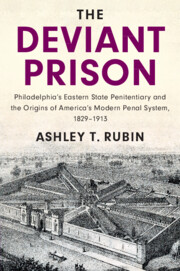 The Deviant Prison
The Deviant Prison from Part III - Forced to Adapt: The Conditions for and Process of Deinstitutionalization
Published online by Cambridge University Press: 12 January 2021
From the very beginning, Eastern’s administrators’ autonomy was challenged directly by occasional incursions from the local penal reformers and indirectly by the state legislature's lackluster patronage. These challenges became more invasive in the 1850s, peaking in the 1860s. In response, Eastern's administrators sought to establish jurisdiction over their prison by proclaiming their own special expertise and insisting on deference in matters affecting Eastern. By the 1870s, however, penal actors on the national stage were likewise proclaiming their own expertise and professional status, while Eastern's administrators felt increasingly irrelevant. In response to these national-level developments, the administrators further developed their claims to professional status. In this context, the administrators' claims to professional status provided them a more promising path to self-aggrandizement than continuing to proclaim the Pennsylvania System's superiority. Consequently, the administrators shifted their focus from the Pennsylvania System to their status as professional penologists. It was this shift from defense to professionalization that deinstitutionalized the Pennsylvania System.
To save this book to your Kindle, first ensure [email protected] is added to your Approved Personal Document E-mail List under your Personal Document Settings on the Manage Your Content and Devices page of your Amazon account. Then enter the ‘name’ part of your Kindle email address below. Find out more about saving to your Kindle.
Note you can select to save to either the @free.kindle.com or @kindle.com variations. ‘@free.kindle.com’ emails are free but can only be saved to your device when it is connected to wi-fi. ‘@kindle.com’ emails can be delivered even when you are not connected to wi-fi, but note that service fees apply.
Find out more about the Kindle Personal Document Service.
To save content items to your account, please confirm that you agree to abide by our usage policies. If this is the first time you use this feature, you will be asked to authorise Cambridge Core to connect with your account. Find out more about saving content to Dropbox.
To save content items to your account, please confirm that you agree to abide by our usage policies. If this is the first time you use this feature, you will be asked to authorise Cambridge Core to connect with your account. Find out more about saving content to Google Drive.